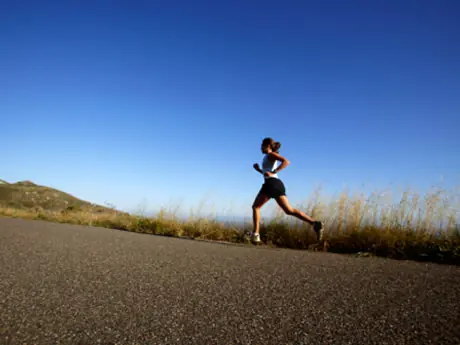13.1
Things get a bit more complicated with the half marathon (13.1 miles). If not done properly, fueling and hydrating can have a negative impact on the outcome of the race. Aim for 150 to 250 calories per hour. You'll have to figure out in training the exact number of calories you need.
These calories can come through a combination of drink—water and/or sports drink—and food including gels, bars and chews. Trial and error during training will help nail down a hydration/nutrition strategy that works best.
Once you know what works, stick to it on race day. Many athletes get so caught up in the excitement of the race they neglect their food and water regimen.
The half marathon is raced below 10K pace, about 15 to 30 seconds slower per mile than 10K pace, in the yellow zone. On a scale of 1 to 10, the half marathon is raced around a 7. Holding back at the start of a half marathon is a smart strategy; it's very easy to go out too fast.
Calculate the average minute/mile goal pace and then start up to 10 to 15 seconds per mile slower than goal pace for up to the first 3 miles of the race. Gradually ease into goal pace for the next 7 miles or so. At mile 10, slowly increase to faster than goal pace for the final 3 miles of the race.
More: Half Marathon Pacing Strategies
26.2
The marathon (26.2 miles) is a tricky distance to race correctly. Because it's such a long race, there's a lot of time to make mistakes and for things to go wrong.
Aside from pacing, fueling and hydrating properly will help determine your level of success at the marathon. Pay careful attention to getting this detail right to stack the odds in your favor. Follow the same fueling guidelines outlined for the half marathon distance.
The marathon is raced well below half marathon pace, about 30 to 60 seconds slower in the green zone. On a scale of 1 to 10, the marathon is raced in the 5 to 6 range. Start out no more than 20 seconds per mile slower than goal pace. It's better to be conservative the first 10 to 13 miles of the race and then slowly pick up the pace to goal pace.
More: 4 Steps to Your Perfect Pace
Too often people run the first half of the race too fast and then have nothing left for the second half of the race. Don't make the same mistake! And know that for every mile you run significantly slower than goal pace, you will have to run faster than goal pace to make that time up. Therefore be cautious about going out too quickly but also be aware that any lost time will need to be made up in order to reach goal pace.
If you find yourself behind, don't try to make up lost time all at once, gradually spread it out over the second half of the race. The marathon doesn't really begin until mile 20 or so; thus patience is critical. At mile 20, if you have anything left in the tank increase the pace to faster than goal pace and try to hang on the final 10K.
Antoine de Saint-Exupery said, "A goal without a plan is just a wish." The key to racing well is to be prepared both physically and mentally. Have a plan, stick to it as best you can.
More: 5 Tips for Marathon Pacing
 Sign up for your next race.
Sign up for your next race.
- 2
- of
- 2
About the Author

Get ACTIVE on the Go


Couch to 5K®
The best way to get new runners off the couch and across the finish line of their first 5K.
Available for iOS | Android







Discuss This Article